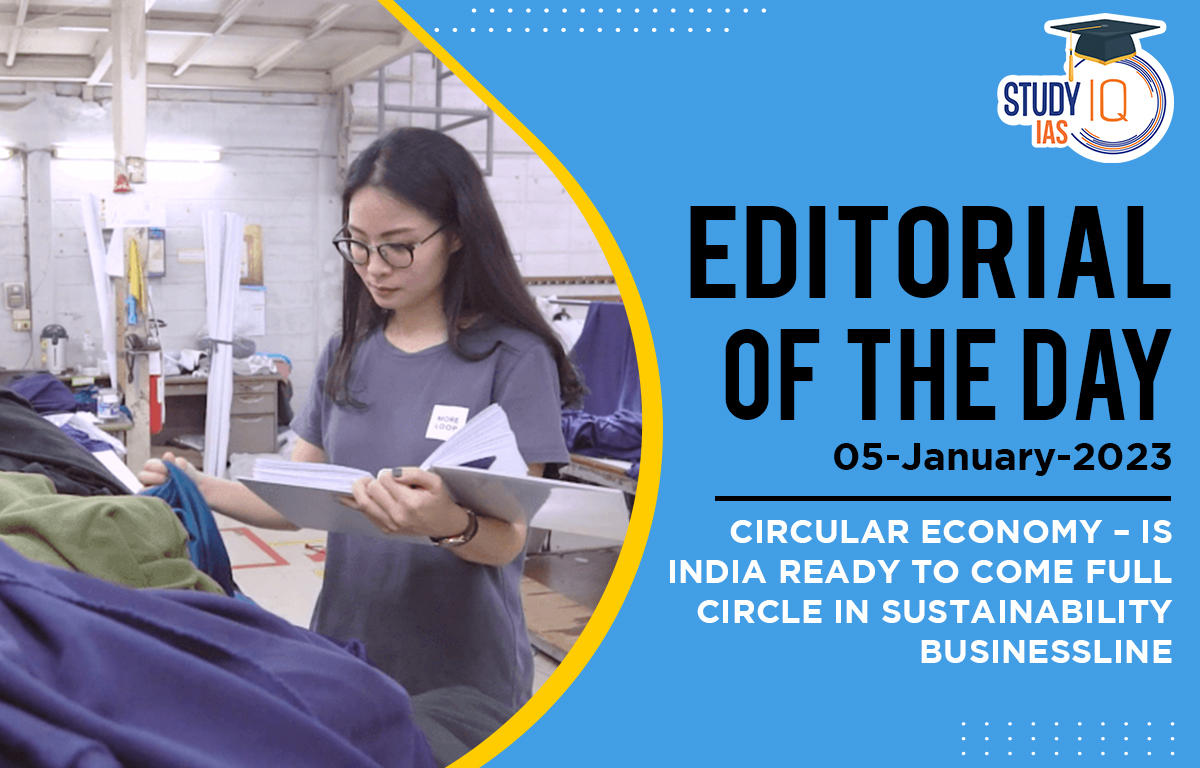Table of Contents
Exam View: Circular Economy, Significance, Challenges and Measures that can be taken to promote it, Battery Waste Management Rules 2022, Plastic Waste Management (Amendment) Rules 2022, e-Waste Management Rules 2022.
In News: The COP27 meeting brought to the fore a circular economy’s relevance in mitigating carbon emissions for India by ensuring responsible consumption and sustainable resource management.

- A Circular Economy is one where products are designed for durability, reuse, and recyclability and thus almost everything gets reused, remanufactured, and recycled into a raw material or used as a source of energy.
- It includes the 6 R’s – Reduce, Reuse, Recycle, Refurbishment, Recover, and Repairing of materials.
- In recent years, the concept of Circular Economy (CE) has gained increasing attention as a way to address a range of environmental and economic challenges. With the growing recognition of the finite nature of many resources and the negative impacts of waste and pollution, the circular economy offers a more sustainable and resilient alternative to the traditional linear model of economic growth.
Needs for Circular Economy in India

India’s Efforts to Promote the Circular Economy
- The Government has notified various rules: such as the Plastic Waste Management Rules, e-Waste Management Rules, Construction and Demolition Waste Management Rules, Metals Recycling Policy, etc. The Rules are geared towards reducing waste generation and maximizing the recycling of waste.
- The 2022-23 Budget recognised the importance of sustainable growth: The government formulated, Battery Waste Management Rules 2022, Plastic Waste Management (Amendment) Rules 2022, and e-Waste Management Rules 2022. These rules set out target waste disposal standards for manufacturers, producers, importers, and bulk consumers, along with enabling transactions among stakeholders for Extended Producer Responsibility (EPR) certificates.
- NITI Aayog has organized an international conference on ‘Sustainable Growth through National Recycling’ and has prepared strategy papers for resource efficiency in sectors like Steel, Aluminium, Construction Demolition and e-waste.
- Formulation of an action plan across 10 sectors: including e-waste, lithium-ion batteries, end-of-life vehicles, scrap metal, municipal solid waste, etc. emphasising the importance of reusing secondary materials.

Way Forward
- Fusion of the government’s ongoing initiatives and pertinent execution tactics: The government’s initiatives need to be in conjunction with implementable actions with industry collaboration to reap the benefits of the circular economy.
- Innovate to create new products and business models and demonstrate their success: Businesses can foster innovation to address challenges, such as transition costs, more rapidly by collaborating with research institutions and by making information open source.
- The renewable energy industry should invest in the research and development of recycling technologies: Investments in R&D could help discover new ways of recycling that result in higher efficiency and a less environmentally damaging footprint.
- Collaborate with other businesses, policymakers, and the informal economy: Participation in pre-competitive collaboration in cross-industry and cross-value-chain networks can enable businesses to drive change that they cannot create on their own.
- Build circular economy knowledge and capacity: Taking maximum advantage of circular models requires decision-makers throughout the organisation to understand the benefits and take them into account in business decisions.
- Invest in circular economy opportunities: While sizing and prioritizing the value of investment related to the circular economy opportunities outlined in this report requires detailed analysis, the circular economy offers attractive opportunities for both businesses and financial institutions.
- Adoption of a circular economy in India will result in yearly benefits of $624 billion by 2050 and a 44% reduction in greenhouse gas emissions. Hence, the circular economy plays a pivotal role in preserving the environmental condition and creating a reward system to encourage the recycling of electronic products.


 Current Affairs 25th April 2024 for UPSC...
Current Affairs 25th April 2024 for UPSC...
 Editorial of the day (25th Apr): UK's Rw...
Editorial of the day (25th Apr): UK's Rw...
 Telangana Judicial Recruitment Notificat...
Telangana Judicial Recruitment Notificat...

















